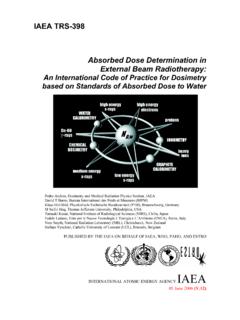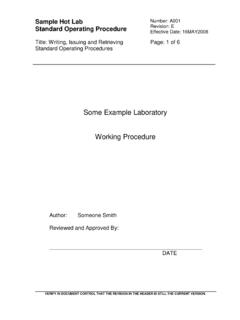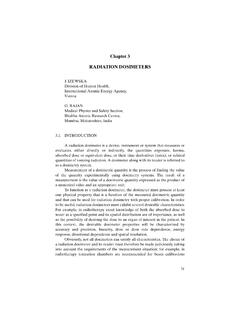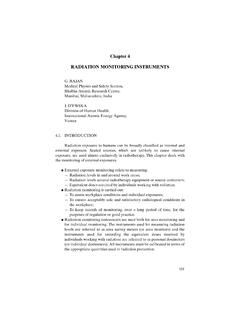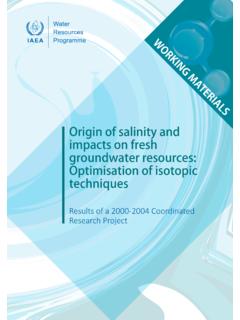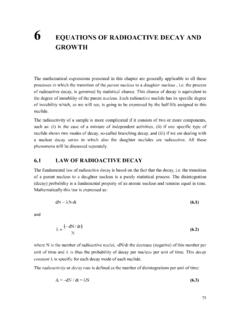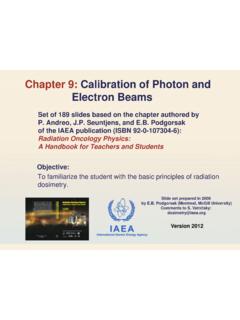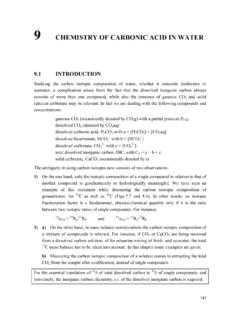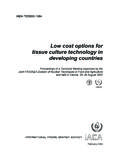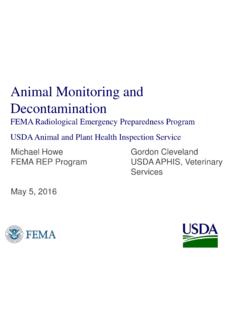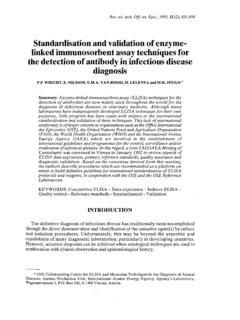Transcription of Quantification of Tannins in Tree Foliage - IAEA
1 Quantification of Tannins in tree FoliageA laboratory manual for the FAO/ iaea Co-ordinatedResearch Project on Use of nuclear and Related Techniquesto Develop Simple Tannin Assays for Predicting andImproving the Safety and Efficiency of Feeding Ruminantson Tanniniferous tree Foliage JOINT FAO/ iaea DIVISIONOF nuclear TECHNIQUES IN FOOD ANDAGRICULTUREA nimal Production and Health Sub-Programme1 Quantification of Tannins in tree FoliageA laboratory manual for the FAO/ iaea Co-ordinatedResearch Project on Use of nuclear and Related Techniquesto Develop Simple Tannin Assays for Predicting andImproving the Safety and Efficiency of Feeding Ruminantson Tanniniferous tree Foliage FAO/ iaea Working DocumentIAEA, VIENNA,2000 ForewordTanniniferous trees and shrubs are of importance in animal production becausethey can provide significant protein supplements, but unfortunately the amounts oftannins that they contain vary widely and largely unpredictably, and their effects onanimals range from beneficial to toxicity and death.
2 The toxic or antinutritional effectstend to occur in times of stress when a very large proportion of the diet istanniniferous. With a better understanding of tannin properties and propermanagement, they could become an invaluable source of protein for strategicsupplementation. As the demand for food rises, tanniniferous plants must play anincreasingly important part in t he diet o f animals, in particular for ruminant s in small-holder subsistence farming in developing countries. It is therefore critical thattechniques be developed to measure and manage the anti-nutritional components thatthey the above in mind, a Joint FAO/ iaea Co-ordinated Research Project(CRP) on Use of nuclear and Related Techniques to Develop Simple Tannin Assaysfor Predicting and Improving the Safety and Efficiency of Feeding Ruminants onTanniniferous tree Foliage has been initiated.
3 In order t o provide so und basis for thisCRP, an FAO/ iaea Consult ants Meeting was held in August 1997 in Vienna, atwhich the tanniniferous plants to be studied, the analytical methods, the test animalsand the animal response evaluation techniques were publication co nt ains met ho dologies for the analysis o f Tannins usingchemical-, protein precipitation/binding- and bio-assays recommended by theconsultants. Dr. Ann Hagerman has contributed the procedure for radio-labelled assayand Dr. Irene Mueller-Harvey for characterization of phenolic compounds using ThinLayer Chromatography. Harinder Makkar was responsible for compiling the detailedexperimental protocols presented in this manual, and for publication of this .. OF PLANT EXTRACT .. Collection, drying and storage of plant material .. Grinding of sample .. Extraction of Tannins .
4 OF TOTAL PHENOLICS AND Tannins USING FOLIN-CIOCALTEU METHOD .. Reagents .. Preparation of calibration curve .. Analysis of total Removal of tannin from the tannin-containing extract .. OF CONDENSED Tannins (PROANTHOCYANIDINS) .. Reagents .. DETERMINATION BY RHODANINE Reagents .. Determination of free gallic acid .. Determination of gallic acid present in free and in gallotannin Calibration curve .. DETERMINATION USING Preparation of sample for determination of free gallic acid .. Preparatio n o f sample fo r determinatio n of gallic acid present in free and ingallotannin OF PROTEIN-PRECIPITABLE PHENOLICS .. Reagents .. Formation of the tannin-protein complex .. Determination of Tannins (phenolics) in tannin-protein Protein precipitable phenolics as percentage of total phenolics .. CAPACITY BY FILTER PAPER Reagents.
5 Preparation of plant extract .. Assay procedure .. DIFFUSION Reagents .. Preparation of Assay procedure .. Sample Reagents .. Weighing of samples and preparation of syringes .. Preparation ofin vitrorumen fermentation buffer solution .. Measurement of microbial protein in the residue (apparent undigestedresidue) left after BSA PRECIPITATION METHOD .. Reagents .. Supplies .. Method for Precipitatio n Assays (amount of BSA precipitated by tannicacid or plant extracts) .. OF PHENOLIC COMPOUNDS BY THIN LAYERCHROMATOGRAPHY (TLC) .. Characterization of condensed Tannins .. Survey of Condensed and Hydrolysable Tannins by TLC .. TLC 24 REFERENCES .. 2511. INTRODUCTIONT annins are generally defined as naturally occurring polyphenolic compounds of highenough molecular weight to form complexes with proteins.
6 These are classified into twogroups based on their structural types a) hydrolysable Tannins and b) condensed for Quantification of Tannins may be based on the chemical properties of tanninsor their capability to bind substrates, particularly proteins. The methods described here can becategorized as follows:A. Chemical methods(a)Determination of total phenolics. The method is based on the fact that phenolics arereducing agents. It may be noted that all Tannins are phenolics but not all phenolics aretannins.(b)Determination of total Tannins . It is partly chemical, based on reducing property oftannins, and partly physical because Tannins are measured as the reduction in phenolicsthat occur when a binding agent (polyvinyl polypyrrolidone, PVPP) is added to theextract.(c)Determination of condensed Tannins (proanthocyanidins).It is based on oxidativedepolymerization of condensed Tannins in butanol-HCl reagent.
7 The presence of iron isco nsidered to increase the repro ducibility and sensitivit y o f the assay.(d)Determination of gallotannins. It is based on hydrolysis of gallotannins to gallic acidunder acidic conditions and measurement of the released gallic acid by reaction withrhodanine or by Protein precipitation/binding methods(a)Determination of protein precipitable phenolics. It is based on the formation of tannin-protein complexes ( Tannins in the plant extract and the protein, bovine serum albumin). Tannins present in the complex are determined using ferric chloride assay for totalphenolics. Iron forms a complex with phenols to give a pink chromatophore which ismeasured spectrophotometrically.(b)Filter paper-protein Ponceau S dye assay. The protein-tannin complexes are formed ona sheet of filter paper, and the protein bound to the complex is measured by dyeing itwith Ponceau S dye.
8 This dye is specific for proteins and does not bind Tannins . Thecolour of the dye bound to proteins is eluted and measured spectrophotometrically.(c)Radial diffusion assay. In this method, tannin molecules migrate through agarose gelwhich is impregnated with the protein, bovine serum albumin (BSA). The tannin-proteincomplex is formed in the gel which appears as a ring. The diameter of the ring is ameasure of protein precipitation/binding capacity of Tannin bioassayThe feeds under investigation (or Tannins ) are incubated in absence and presence of atannin-complexing agent, polyethylene glycol (PEG) in thein vitrorumen fermentation systemcontaining rumen microbes. The affinity of PEG for binding to Tannins is very high; it evenbreaks the already formed tannin-protein complexes and releases proteins from the complex.
9 Inthein vitrorumen fermentation system, release of gas and production of microbial mass are2measured. The difference between these parameters observed in absence and presence of PEGis a measure o f tannin activity in relat ion to their effects on rumen PREPARATION OF PLANT EXTRACTThe general problem in the study of natural plant products is that their nature andamount are dependent on various factors, which must be controlled as far as possible. Some ofthese factors are: i) stress; the metabolic state of the plant may change when it is stressed inany manner. This can be a problem before as well as after harvesting a plant part for cells die (the senescent process), the cellular integrity is lost and as a result the enzymescome in contact with substrates to which they are not normally exposed in living cells. Inaddition, it also increases the oxidation process, which is a problem with phenolics since theseare prone to oxidation.
10 On oxidation, phenolics oxidise to quinones and then polymerizationreaction could follow. If a plant is cut and dried under near ambient conditions, whichgenerally requires a large time to dry, the nature and content of phenolic compounds canchange. In order to avoid these changes, the metabolic activities of the cells need to be curbedimmediately. The next important step is to bring the chemical constituents into solutions fortheir Collection, drying and storage of plant materialLeaf age and stage of development affect levels and nature of phenolics. Therefore, it isimportant to define the stage of maturity of plant and leaf as close as possible before collectingleaf material for analysis. When the collection site is close to the laboratory, the material can betransported to the laboratory in fresh state. The fresh material should be kept on ice andtransported under dark conditions.
